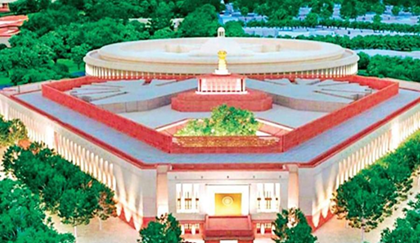

17th March 2023 (6 Topics)
Context
An official vision document entailing the objectives of artwork at the upcoming Parliament building shows that artworks and their installation represent Sanatan parampara and Vasstu shastra that continued over thousands of years.
|
Sanatan parampara broadly refers to Hindu culture, which is believed to have been in continuity for centuries. Vaastu shastra is the traditional Indian system of architecture based on ancient texts that describe principles of design, layout, measurements, space arrangement and spatial geometry. |
About the Central Vista Redevelopment Project:
- A 3.2-kilometre stretch in Delhi which includes Rashtrapati Bhawan, Parliament House, North and South Block, India Gate, and National Archives among others is the ‘Central Vista Project’.
- 1931 the year in which the new capital was inaugurated all these iconic buildings were constructed before that.
- For the construction of a new parliament building that will be close to the existing one, the Central Vista Redevelopment Project is the government’s plan.
- It includes an area covered by central administrative buildings and residential buildings at Raisina Hill, New Delhi, India, which is set under revamping.
- At the time of British colonial rule, the place was built but later retained by the Indian government after the independence.
- The planners of the area were Herbert Baker and Edward Lutyens.

Key Features of the New Building:
- In 2019 it was proposed by the Union Ministry of Housing and Urban Affairs.
- A ‘triangular Parliament building’ next to the existing one is to be constructed.
- Common Central Secretariat Construction is done.
- From Rashtrapati Bhavan to India Gate-Revamping of the 3-km-long Rajpath.
- As museums North and South Block to be reconverted.
- The consultancy bid to revamp Central Vista was won by Ahmedabad-based firm - HCP Design, Planning and Management Pvt Ltd.
- As an archaeological asset of the country, the existing Parliament building will be conserved.
- The basement, ground, first and second four floors in the new Parliament have It will integrate indigenous architecture and the height will be the same as the new building.
- Reconstructed of Prime Minister's Office and the residences of the Prime Minister and Vice President will be done.
- Under this project, Nirman Bhavan, Krishi Bhavan, and Vigyan Bhavan will be demolished.
- CPWD (Central Public Work Department), India is the developer of the project.
- Starting from 2020 to 2024 duration will be around 4 years.
- Tata Projects Ltd. won the contract for the construction of the new building.
- At the existing Shram Shakti Bhawan, a new complex will be constructed for the Members of Parliament of both Houses.
Highlights of Ancient Artworks model:
- The new building is going to have six entrances to exhibit “guardian statues showing auspicious animals.
- These “auspicious animals” have been chosen based on their importance in Indian culture, vaastu shastra and traits such as wisdom, victory, power and success.
- Each animal chosen to be installed in the building possesses a set of affirmations, spreading well-being and harmony.
- Importance of Direction:
- The North: Guarding the ceremonial entrance to the north is the gaja (elephant), which represents wisdom, wealth, intellect and memory.
- According to vaastu shastra, the northern direction is associated with Mercury, which is the source of higher intellect.
- The South: The southern entrance is the ashva (horse), which is symbolic of endurance, strength, power and speed — describing the quality of governance.
- The East: Soaring at the eastern entrance is the garuda (eagle), which symbolises the aspirations of the people.
- In vaastu shastra, the east is associated with the rising sun, representing victory.
- The northeastern entrance has hamsa (swan), representing discernment and wisdom.
- The remaining entrances showcase the Makara (a mythical aquatic creature that is a combination of the body parts of different animals), which represents unity in diversity, and the shardula (a mythical animal that is said to be the most powerful of all living beings), which symbolises the power of the people of the country.
- Remains of India’s freedom struggle:
- The new building will have six granite statues devoted to personalities involved in the freedom struggle and making of the Constitution, four galleries each for the two Houses, three ceremonial foyers, as many India galleries and one Constitution gallery.
- Depicting Art and Culture:
- Inside the building, each wall will have a theme reflecting a certain aspect, such as contributions by tribal and women leaders.
- The artworks used indicate the 5000 years old culture of India.
- There will be an adequate focus on Indian knowledge traditions, the Bhakti tradition, Indian scientific traditions as well as monuments.


